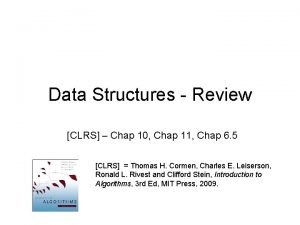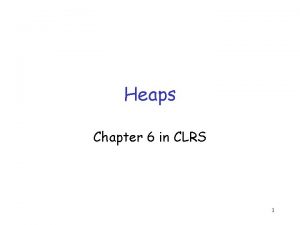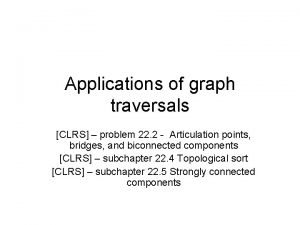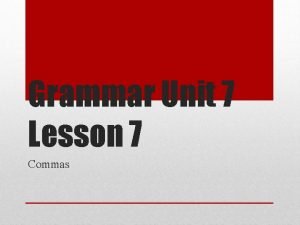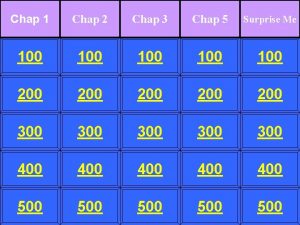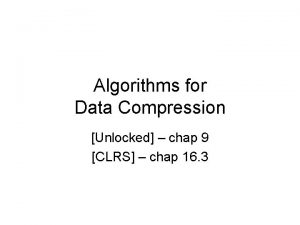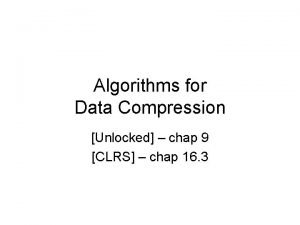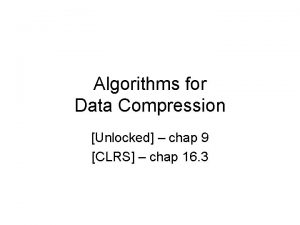Data Structures Review CLRS Chap 10 Chap 11
![Data Structures - Review [CLRS] – Chap 10, Chap 11, Chap 6. 5 [CLRS] Data Structures - Review [CLRS] – Chap 10, Chap 11, Chap 6. 5 [CLRS]](https://slidetodoc.com/presentation_image_h/f21e1de5e9126bad34fd6e53cb0eaeb7/image-1.jpg)






- Slides: 7
![Data Structures Review CLRS Chap 10 Chap 11 Chap 6 5 CLRS Data Structures - Review [CLRS] – Chap 10, Chap 11, Chap 6. 5 [CLRS]](https://slidetodoc.com/presentation_image_h/f21e1de5e9126bad34fd6e53cb0eaeb7/image-1.jpg)
Data Structures - Review [CLRS] – Chap 10, Chap 11, Chap 6. 5 [CLRS] = Thomas H. Cormen, Charles E. Leiserson, Ronald L. Rivest and Clifford Stein, Introduction to Algorithms, 3 rd Ed, MIT Press, 2009.

Data Structures • Program = Algorithm + Data Structures • The design of an algorithm must be based on the understanding of data structure techniques and costs • Abstract Data Type: – Defined by the list of supported operations – Hides the implementation details of these operations

Dynamic Sets • Collections of data manipulated by algorithms; can grow, shrink or change over time • Operations on dynamic sets: – – – – Search (S, k) Insert (S, x) Delete (S, x) Minimum (S) Maximum(S) Successor(S, x) Predecessor(S, x)

Implementing Dynamic Sets • The best way to implement a dynamic set is determined by the subset of operations that must be supported ! • There are particular types of Dynamic Sets, determined by certain frequent occuring subsets of operations: The Fundamental Data Structures – Each data structure addresses comes with a purpose: it addresses a particular usage context that requires a particular subset of operations

Fundamental Data Structures • Stacks: – Insert (Push), Delete (Pop) – Implemented by Lists; O(1), O(1) • Queues: – Insert (Enqueue), Delete (Dequeue) – Implemented by Lists; O(1), O(1) • Priority Queues: see for review [CLRS chap 6. 5] – Insert, Maximum, Extract. Max, Increase. Key – Implemented by Heaps; O(log n), O(1), O(log n) • Dictionaries: – Insert, Search, Delete – Implemented by Hashtables: see for review [CLRS chap 11] – Generalizes the simple arrays, allows direct addressing of arbitrary positions in O(1) – Hashing with chaining; Hashing with open addressing

Libraries Implementing Fundamental Data Structures • There are standard libraries implementing the fundamental data structures for most languages • It is recommended to use these implementations instead of redoing your own ! • BUT: in order to use them correct and appropriate, don’t forget anything that you learned about fundamental data structures ! • Java: Collections – https: //docs. oracle. com/javase/tutorial/collections/TOC. html • C++: STL Containers – http: //www. cplus. com/reference/stl/ • C#: System. Collections – https: //msdn. microsoft. com/en. US/library/system. collections%28 v=vs. 110%29. aspx

Fundamental Data Structures - Java • Class java. util. Stack • Interface java. util. Queue – General purpose (not for concurrent use) queue implementation: class java. util. Linked. List • Interface java. util. Deque – General purpose implementations: classes java. util. Array. Deque, java. util. Linked. List • Class java. util. Priority. Queue – Implements an unbounded priority queue based on a Heap. • Class java. util. Hash. Set • Class java. util. Hash. Map
